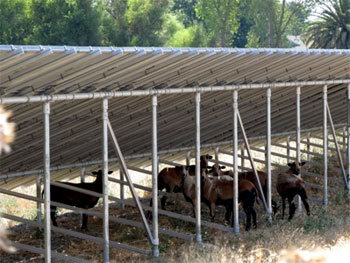As of 2012, 57,299 of our nation’s farms produce on-site renewable energy, according to the USDA Census, more than double the 23,451 in 2007.
Solar is the most popular resource, used by 36,000 farms, followed by geo-exchange systems and wind turbines, each used on about 9,000 farms. About 1300 farms use small hydro and 537 have biogas systems.
That’s pretty impressive even if it still makes up a small percentage of US farms. USDA’s 2012 census, released last week, shows there are 2.1 million farms taking up 914.5 million acres.
USDA’s Rural Energy for America Program (REAP) funds up to 25% of a renewable energy system (solar, wind, biogas) or energy efficiency upgrades and provides additional support through loan guarantees. 8,250 projects have been installed under the Obama administration, with more to come because it made it into this year’s Farm Bill.
For 2014, USDA plans to award up to $12.3 million in grants and $57.8 million in loan guarantees.
Read our article, Farms Offer New Market for Renewable Energy.
Compare the number of farms with renewable energy to all the organic farms in the country. Even thought it’s booming, with $31.5 billion in sales (up from $1.7 billion in 2007), organic acreage is tiny with 17,600 organic farms spread over 4.6 million acres – 0.8% of the total value of US food production. Amazing how long it takes to make a dent in conventional farming.
Horses find shade under solar arrays at organic Lundberg Farms:

Lots of conventional farms have moved to conservation tillage or no-till practices, however – 474,028 farms covering 173.1 million acres.
And 144,530 farmers sell direct to consumers with sales over $1.3 billion (up 8.1%).
"Once every five years, farmers, ranchers and growers have the unique opportunity to let the world know how U.S. agriculture is changing, what is staying the same, what’s working and what we can do differently," says Dr. Cynthia Clark, head of USDA’s National Agricultural Statistics Service.
Some interesting statistics:
- Both sales ($394.6 billion) and production expenses ($328.9 billion) reached record highs in 2012;
- 75% of farms are small, producing 3% of products with sales under $50,000. 4% of all farms produce 66% of products with sales over $1 million;
- Corn and soybean acres topped 50% of all acres harvested for the first time;
- Cows raised for beef are the biggest food category, accounting for 29% of farms and ranches (619,172);
- Not surprisingly, farming is concentrated geographically. California has 9 of 10 top counties for sales, led by Fresno with $5 billion;
- Top 5 states: California ($42.6 billion); Iowa ($30.8 billion); Texas ($25.4 billion); Nebraska ($23.1 billion); and Minnesota ($21.3 billion);
- 87% of US farms are operated by families or individuals, on average 58.3 years old and predominantly male;
- Young farmers increased 11.3%, however, to 40,499 people, and minority-operated farms are increasing, especially Hispanics at 21%.
One of the newer risks on farms is aquaculture, particularly for their negative impacts on wild salmon. Last year, the USDA opened the door to expand British Columbia’s open net-cage industry, accepting 13 applications for the Pacific Northwest.
Monterey Bay Aquarium’s Seafood Watch and Canada’s SeaChoice program both rated that industry with a "avoid buying" designation. There are many problems: what they feed farmed salmon, disease transmission between farmed and wild salmon, and concentrations of many farms in small areas. Over 90% of wild salmon die before they return to freshwater to spawn – most of them in the first months after they enter the ocean, according to the David Suzuki Foundation.
"Aquaculture must stop using the ocean as a free waste-treatment system," says Dr. Suzuki. "Closed-containment – in the ocean or on land – is better at controlling water and removing feces and chemicals like antibiotics and pesticides used for sea lice. One British Columbia open net-cage company lost more than $200 million in one year because of disease, enough to build 10 closed-containment farms. Yet the industry claims closed alternatives cost too much."
